Martin Gardner's Books on Skepticism
"Modern skepticism has developed into a science-based movement, beginning with Martin Gardner's 1952 classic"—Michael Shermer in Why People Believe Weird Things: Pseudoscience, Superstition, and Other Confusions of Our Time (1997)
Martin devoted a great deal of his energy to writing about fringe science, skepticism and rationality, and much of what he wrote ended up in the dozen volumes highlighted here. But we chose to start and finish with more modest affairs, two articles he wrote that nicely serve to bookend this aspect of his career.
From a publishing perspective, it started with "The Hermit Scientist", that Martin wrote for The Antioch Review (Vol 10, 447–457, Dec 1950). There, he'd optimistically but mistakenly concluded, "The current flurry of discussion about Velikovsky and Hubbard will soon subside, and their books will begin to gather dust on library shelves."
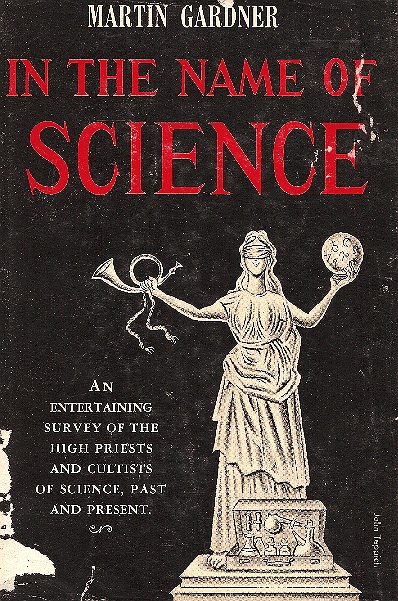

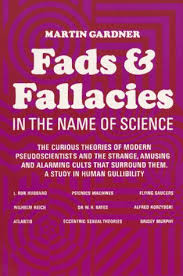
Martin's first book under his own name was In the Name of Science (Putnam, 1952, 320 pages), subtitled, "An Entertaining Survey of the High Priests and Cultists of Science, Past and Present," and it was a comparitive flop at the time. It grew out of "The Hermit Scientist" article mentioned above, and garnered several reviews in Sci Fi magazines among other places, but was not a big seller.
Five years later, under a new title, Fads and Fallacies in the Name of Science (Dover, 1957), it took off bigtime.
Today, it is considered to have been a key catalyst in the starting of a worldwide skepticism movement that flew in the face of irrationality and fringe science. There was also a significantly abridged issue under the original title from Ballantine in 1957, and the Dover version was republished by New American Library in 1986.
Martin wrote for New York Review of Books frequently, going back to 1966. His contributions there include numerous pieces (and letters to the editor) concerning dubious religious preachers, pseudoscience and skepticism.
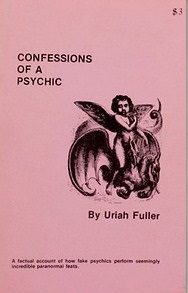
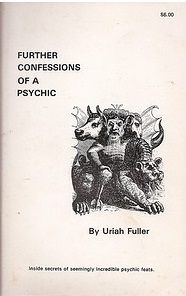
Under the alias Uriah Fuller, Martin wrote Confessions of a Psychic (Karl Fulves, 1975, 40 pages) and Further Confessions of a Psychic (Karl Fulves, 1980, 69 pages), both subtitled "The Secret Notebooks of Uriah Fuller" and put out in limited circles by his friend, prolific magic writer Karl Fulves in Teaneck, NJ. These are guides to "inside secrets of seemingly incredible psychic feats"—inspired by the worldwide popularity of Uri Geller in the 1970s. (The 15-page Publisher's Note at the start of the second book is dated Jan 1978, suggesting a two-year delay in publication.)
The author's 4-page Introduction is priceless, adopting a cranky persona when discussing both books.
"I still don't know who the traitor was among my so-called pals who Xeroxed my secret diary and sold it to Karl Fulves. I was damn angry when Fulves published it, and even more ______ off when John Wilhelm [] listed Confessions of a Psychic in his bibliography and said it was written by somebody else.""Some people even think Randi wrote Confessions of a Psychic! Randi may be a clever performer, but who invented all those tricks Randi does when he exposes me and Uri? It wasn't Randi and it wasn't Uri. It was Uriah Fuller!
"If I'm so mad at Fulves for printing my diary, how come I'm doing this sequel for him? Good question. Let me explain."
"The occult revolution is changing. The big new trend is toward JC, by which I don't mean Jimmy Carter. There's much more loot now in being an evangelist and faith healer than in being a psychic. Besides, Billy Graham Cracker and other fundamentalist big shots have convinced the born-againers that occultism comes straight from the Devil and his demons, not from God and the angels. Parapsychology isn't going to fade away, but things like spoon bending and levitation and teleportation are beginning to frighten the fatheads. The psi scene has developed bad vibes. So;mdash;more than a year ago I gave up the psi racket, changed my name, and am now a Bible-pounding Pentecostal preacher. Never mind what my new name is. I've grown a beard and dyed my hair. I wear colored contact lenses to hide those baby blue eyes of mine. Nobody but Schleppi knows I'm Uriah Fuller!"
"That's why I don't mind writing now about more of my secrets. I particularly don't mind when Fulves comes to me with a basket of bread for a new manuscript. What I need most right now is money."
"What I've tried to do is explain some things I left out of my first book, and add some new things I've been using since that book was published. Everything I write about is practical for the kind of performer I used to be and Uri still is. Poor Uri. Everybody's so bored now with his skimpy repertoir. All he can do is the same old crap I used to do—bend keys and spoons, pick out the little can with the water, start 'broken' watches, duplicate a drawing, and so on. Every time he tries a new trick he bombs. His act gets cornier and he gets seedier."

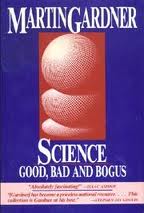
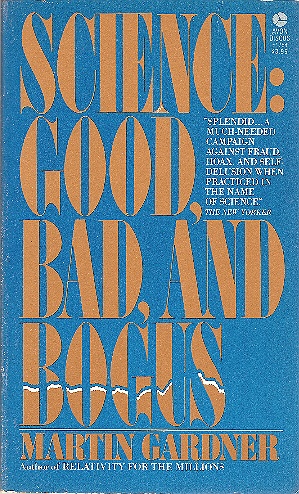
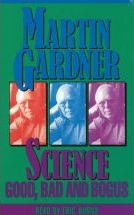
As Martin neared the end of his days as a regular Scientific American columnist, he published what many regard as the sequel to Fads and Fallacies, namely, Science: Good, Bad, and Bogus (Prometheus, 1981, and Avon, 1983, 17 + 412 pages). It came with ringing endoresements from Isaac Asimov and Stephen Jay Gould. Martin opened it by revisiting the Hermit Scientist issue from three decades earlier, before moving on to seventeen chapters on dishonest and diluded science, cranks and crackpots, taking in trends in pseudoscience, Targ's ESP teaching machine, magic and paraphysics, notable scams of science, parapsychology, ESP, Geller, quantum/quack theory, and Tart's failed replication. Numerous book reviews take up the second half of this volume.
Details can be found here. The last cover shown above is for the unusual two-cassette version from 1996, narrated by Eric Burns.
This marked the start of a long and fruitful relationship with Prometheus Books, which is surveyed in the tribute essay Martin Gardner's Contributions to the World of Books by his friend and fellow CSICOP founder Paul Kurtz in Skeptical Inquirer.
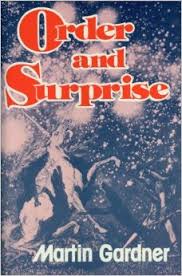
Order and Surprise (Prometheus, 1983) collected essays and reviews written over a four decade period. A few of its chapters are about fringe science.
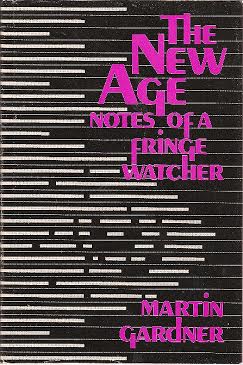

In 1983, Martin started writing a regular Skeptical Inquirer column called "Notes of a Psi-Watcher." In due course, the column was renamed "Notes of a Fringe-Watcher," and he contributed material to it until 2002.
The first nineteen columns—suitably updated—resurfaced in the book The New Age: Notes of a Fringe-Watcher (Prometheus, 1988, 273 pages), alongside like-minded essays and book reviews that had appeared in the New York Times, The New York Review of Books, and Discover. This was the sequel to Science: Good, Bad, and Bogus.

Martin really goes to town on how so-called scientists—not to mention the people at the Guinness Book of Records—allowed themselves to be deceived in How Not to Test A Psychic: Ten Years of Remarkable Experiments with Pavel Stepanek (Prometheus, 1989, 264 pages). The period in question was 1961–1971.

On the Wild Side (Prometheus, 1992, 257 pages), subtitled "The Big Bang, ESP, The Beast 666, Levitation, Rainmaking, Trance-Channeling, Séances and Ghosts, and More...," was the second anthology mixing "Fringe-Watcher" columns with other writing. It has New York Review of Books and Free Inquiry essays and reviews in addition to sixteen Skeptical Inquirer columns. Details are provided here. It's considered to be the fourth in the series started with Fads and Fallacies.
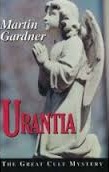

On page 55 of his memoirs, Martin explains how he came to write Urantia: The Great Cult Mystery (Prometheus, 1995, 445 pages), commenting, "My wife, Charlotte, thought my book on the Urantia movement was a huge waste of time, and I suspect she was right." On the next page, he adds, "Did my hatchet job on the Urantia movement cause any true believer to question the book's claims? I doubt it. I know of no Urantian who left the cult because of my book."

Weird Water and Fuzzy Logic: More Notes of a Fringe-Watcher (Prometheus, 1996, 260 pages) was the third anthology of "Fringe-Watcher" columns combined with other related writing. It has a further sixteen Skeptical Inquirer columns and over 30 reviews. Details are provided here. It's considered to be the fifth in the series started with Fads and Fallacies.
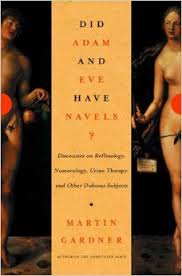
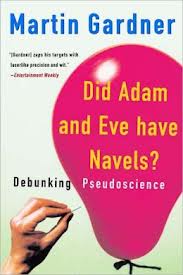
Did Adam and Eve Have Navels? (W. W. Norton, 2000, 11 + 333 pages) is subtitled "Discourses on Reflexology, Numerology, Urine Therapy, and Other Dubious Subjects." It was dedicated "To Kendrick Fraser, editor of Skeptical Inquirer, friend, and leader of the never-ceasing battle against superstition, paranormal nonsense, and dubious science."
It's the fourth anthology of "Fringe-Watcher" columns, and its 28 essays are spread over ten parts: Evolution v. Creationism, Astronomy, Physics, Medical Matters, Psychology, Social Science, UFOs, More Fringe Science, Religion, and The Last Word. It's considered to be the sixth in the series started with Fads and Fallacies.
Arthur C. Clarke was so inspired that he wrote: "Did Adam and Eve Have Navels? should be compulsory reading in every high school—and in Congress."

Are Universes Thicker than Blackberries? (W. W. Norton, 2003, 11 + 288 pages) is subtitled "Discourses on Godel, Magic Hexagrams, Little Red Riding Hood, and Other Mathematical and Pseudoscientific Topics."
It's the fifth and final anthology of "Fringe-Watcher" columns, and its 33 essays are spread over five parts (Science, Mathematics, Religion, Literature, and Moonshine). It's considered to be the seventh in the series started with Fads and Fallacies.
We'd be remiss if we didn't mention "Oprah Winfrey: Bright (but Gullible) Billionaire", one of Martin's very last publications, for Skeptical Inquirer (34.2, Mar/Apr 2010).
He was, first and last, a debunker.